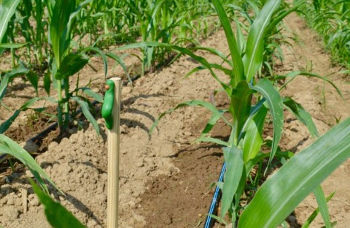By Adam Thomas
UD scientists examine how plants protect themselves by emitting scent cues for birds
When plants are in distress or being fed on by insects, they have been known to send out sensory volatile cues that alert organisms in the area — such as birds — that they are in need of help. While research has shown that this occurs in ecosystems such as forests, until now, this phenomenon has never been demonstrated in an agricultural setting.
Researchers at the University of Delaware have recently found that agricultural plants also send out these signals when under duress from insects, opening new potential avenues for growers to defend their crops while at the same time providing a much-needed food source for birds.
Ivan Hiltpold and Greg Shriver led the research at UD and used an unorthodox method to create their ‘larvae’ for the study: a little bit of Play-Doh and orange colored pins.
Using a field plot of maize on UD’s Newark farm, the researchers attached dispensers using a synthetic odor blend that replicated the volatiles—odor cues given off by plants to indicate they are being attacked such as the smell of freshly cut grass—attached to corn stalks. They also used dispensers using only an organic solvent as a control measure.
The Play-Doh larvae with orange head pins were then distributed on plants around the volatile dispensers and the organic solvent dispensers with the researchers measuring the bird attacks or pecks on the larvae.

They found that the imitation larvae located closer to the volatile dispensers had significantly more attacks than those located closer to the organic solvent dispensers.
The results of their study were recently published in the Journal of Chemical Ecology.
Hiltpold said the results support growing evidence that foraging birds exploit volatile cues and a more accurate understanding of their behavior will be critical when implementing pest management programs benefiting from ecological services provided by insectivorous birds.
“Improving our understanding of how birds prey on insects would open new avenues in sustainable pest control,” said Hiltpold.
While it has been proven for years that parasitoid insects or predatory insects respond to volatiles released by damaged plants and it has also been demonstrated that birds react to tree volatiles after insect herbivory on a tree in a forest setting, Hiltpold, assistant professor in the Department of Entomology and Wildlife Ecology, said that this is the first time field research has been conducted on volatiles in an agricultural setting.
“It is a cry for help,” said Hiltpold. “The plant is damaged, the plant emits something that recruits help and we’re all thinking it’s help from other insects but it seems that birds are also using that as a cue to locate a plant or a group of plants. Then what we think is that they use their visual equity to locate the larvae when they’re in the vicinity of the plant emitting the volatiles.”
Hiltpold said that their research in the field confirmed this, as they had one larvae located on a volatile dispenser on a plant, and then four larvae distributed on all the plants around the plant with the dispenser.
When they compared the number of pecks to the larvae on the plant with the dispenser to the number of pecks on the larvae on plants around the dispenser, there was no significant difference.
“This means that the bird is coming, smelling the volatiles and when it gets to the vicinity of the plant that is damaged, then it visually searches for the insect,” said Hiltpold.
It is also interesting because birds have long been believed to not be able to smell, but this research indicates that they are smelling the volatiles and then coming in closer to visual locate their prey.
“Whether or not birds can smell is a big question because they apparently lack some anatomical things to smell the way other vertebrates are smelling,” Hiltpold said. “Yet, they seem to have the capability of sensing volatiles but we don’t exactly know how they do it yet.”
The next step for the researchers will involve monitoring the diversity of birds responding to these cues in agricultural, forest and wetland environments over the course of the summer.
To evaluate bird predation of fake insects, caterpillars will be visually assessed once a week. To know which birds are responding to volatiles, two time-lapse cameras will be set up per environment to collect pictures over the course of the experiment.
Source: udel.edu